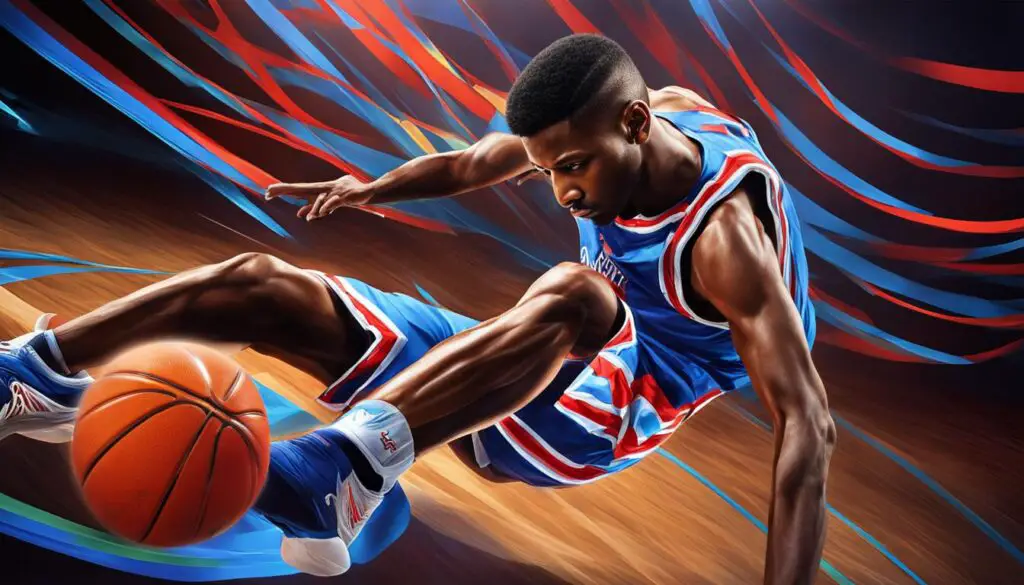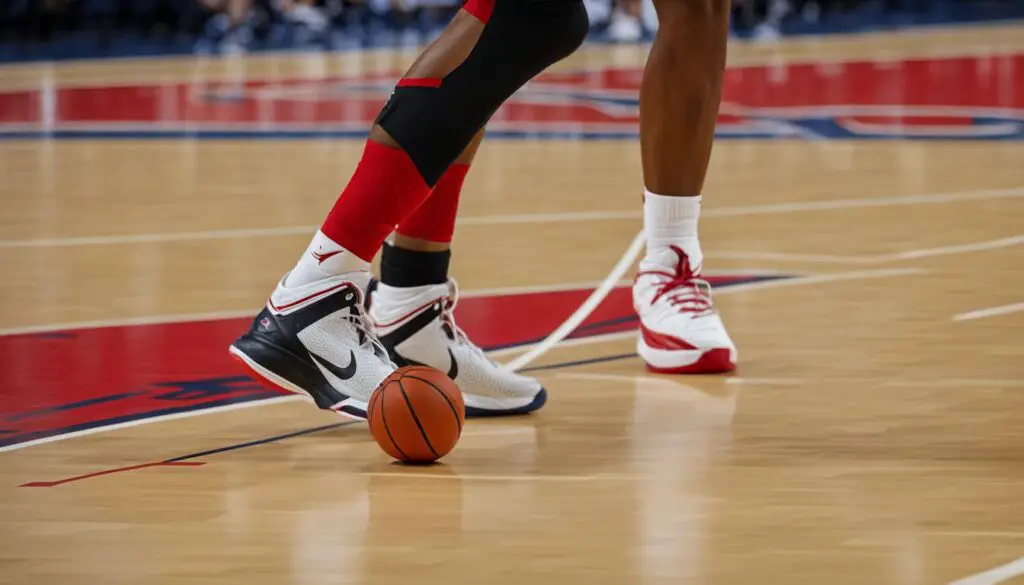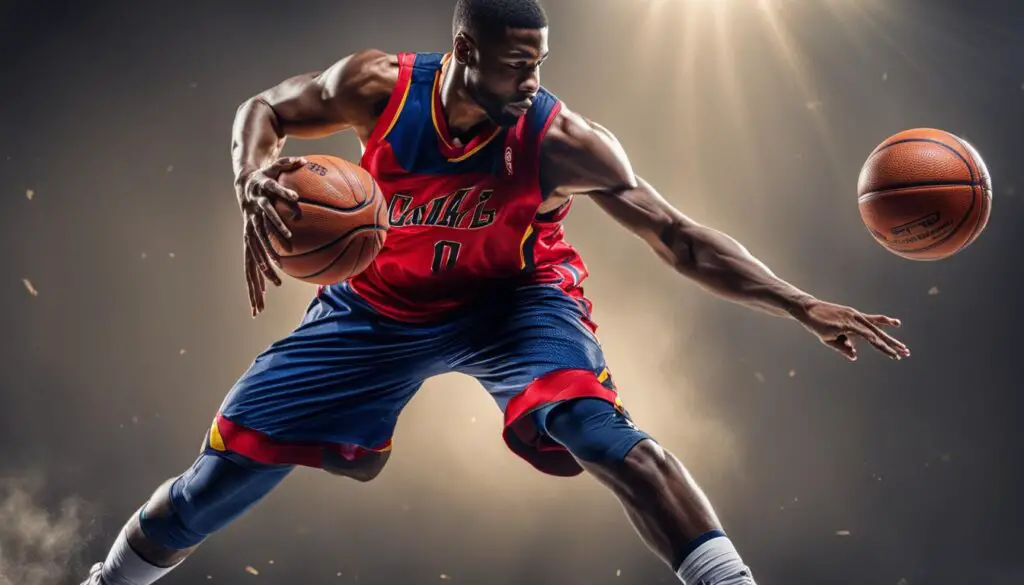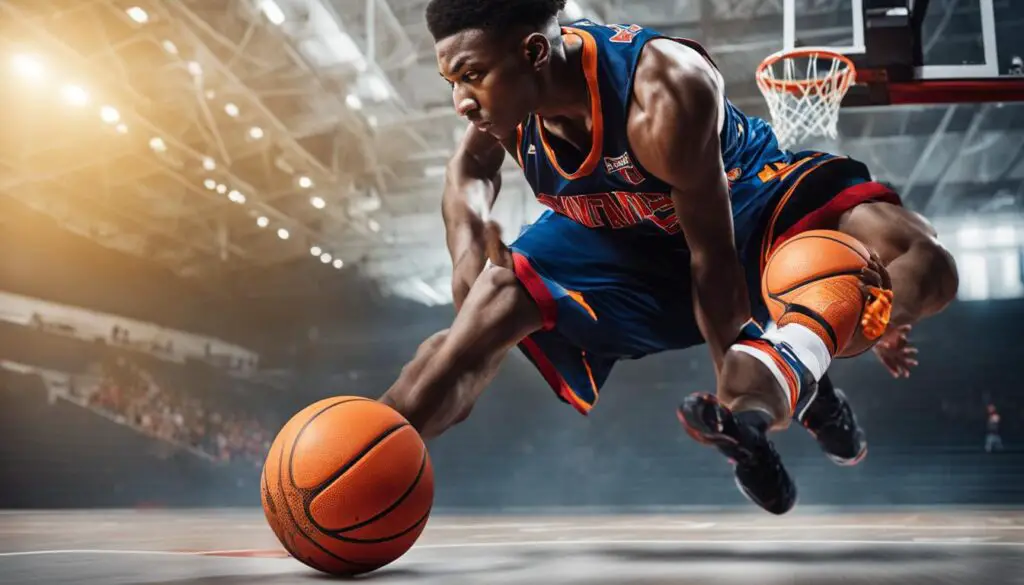Basketball players are often seen wearing rubber bands on their knees during games and practice sessions. These knee rubber bands serve an important purpose in providing support and protection to their knees. But why do basketball players wear these rubber bands on their knees? Let’s explore the reasons and benefits behind this practice.
Key Takeaways:
- Knee rubber bands provide support and stability to basketball players’ knees.
- They help reduce pain, inflammation, and the risk of knee injuries.
- Rubber bands increase blood flow to the knee joint, aiding in faster recovery.
- They can improve ball control and shooting accuracy for better performance on the court.
- Choosing the right knee band and proper care are essential for optimal benefits.
The Function of Knee Rubber Bands in Basketball
Knee rubber bands play a significant role in basketball, providing multiple benefits to players. They serve various functions that contribute to better performance, injury prevention, and improved ball control. Let’s explore the purpose and significance of knee bands in basketball.
- Stabilizing the knee joint: Knee rubber bands help stabilize the knee joint by providing external support. They assist in keeping the knee in the proper alignment during movements, reducing the risk of injuries and promoting optimal performance.
- Reducing strain on the patellar tendon: The patellar tendon is under constant stress during basketball activities. Knee bands help to distribute the force and reduce strain on the patellar tendon, alleviating pain and preventing potential tendon-related issues.
- Supporting ligaments and tendons: Basketball requires quick movements, jumps, and landings, putting strain on the ligaments and tendons surrounding the knee. Knee bands provide additional support to these structures, minimizing the risk of sprains and strains.
- Improving blood flow: By applying gentle pressure to the knee, rubber bands promote increased blood flow to the joint. This enhanced circulation aids in reducing inflammation, promoting healing, and supplying the necessary nutrients for optimal joint function.
- Reducing friction: Knee bands can help reduce friction between the skin and fabric or neoprene material of the knee support. This decreased friction allows for smoother movements, enhancing overall comfort and preventing chafing.
- Enhancing ball control: Proper ball control is crucial for basketball players. Knee rubber bands improve ball control by providing stability to the knee joint, aiding in maintaining balance and coordination during dribbling, shooting, and passing.
Overall, knee rubber bands offer basketball players the support, stability, and flexibility they need to excel on the court. Their function extends beyond injury prevention, improving blood flow, and enhancing ball control. Incorporating knee bands into their game can positively impact a player’s performance and contribute to their overall success.
The Mechanism Behind Knee Rubber Bands
Knee rubber bands play a crucial role in improving performance and stability in basketball. By applying pressure to the patellar tendon, these bands effectively reduce strain and tension on the knee, allowing athletes to perform at their best.
During explosive movements like jumping and landing, the knee rubber bands provide extra support and stability, minimizing the risk of injuries. They help keep the knee in proper alignment, preventing misalignment and potential damage to the joint.
The use of knee rubber bands in basketball is not limited to injury prevention. Athletes wear them because they enhance overall performance on the court. The bands promote better form, stability, and control during high-impact movements, leading to improved agility, speed, and power.
Furthermore, using rubber bands for knee stability in basketball can have a positive impact on an athlete’s endurance. By reducing the strain on the knee joint, these bands help delay muscle fatigue and allow players to maintain optimal performance for longer periods.
Overall, knee rubber bands are a valuable tool for basketball players. They not only provide stability and support to the knee but also improve athletic performance, leading to better agility, endurance, and control on the court.

The Types of Knee Bandages for Basketball Players
Basketball players have various options when it comes to knee support. Different types of knee bandages provide specific benefits and cater to different needs. Here are three common types of knee bandages used by basketball players:
1. Patellar Tendon Straps
Patellar tendon straps are a popular choice for basketball players. They are designed to distribute force evenly across the patellar tendon, reducing pain and inflammation. By applying targeted pressure on the tendon, these straps help alleviate discomfort while providing stability and support to the knee joint during dynamic movements on the court.
2. Compression Knee Sleeves
Compression knee sleeves are another widely used knee support option in basketball. These sleeves are made of stretchy and breathable materials that provide compression to the knee joint. The compression helps increase blood flow, reduce swelling, and provide stability. By offering a combination of support and flexibility, compression knee sleeves enhance performance and aid in injury prevention.
3. Hinged Knee Braces
In more severe cases of knee instability or pre-existing knee conditions, basketball players may opt for hinged knee braces. These braces feature hinges that provide additional support and stability to the knee joint. Hinged knee braces are designed to prevent ligament tears and other injuries by limiting the range of motion and protecting the knee during high-impact movements.
With the variety of knee bandages available, basketball players can choose the type that best suits their needs in terms of support, comfort, and level of protection. It’s important to consult with a healthcare professional or sports therapist to determine the most suitable knee support option for individual requirements.
How to Choose and Use Knee Bands in Basketball
When it comes to selecting the right knee band for basketball, there are a few important factors to consider. The level of support needed is crucial in determining the right band for your needs. Whether you require mild support for preventive measures or more substantial support for existing knee conditions, choosing the appropriate band is essential for optimal performance on the court.
Comfort and breathability are also key considerations. Look for knee bands that are made from high-quality materials, such as neoprene, which provide both comfort and durability. Good breathability will help to prevent excessive sweating and discomfort during intense gameplay.
Proper fit is another vital aspect when choosing a knee band. It should be snug enough to provide stability and support without causing discomfort or restricting movement. A band that is too tight may hinder circulation, while one that is too loose might not provide sufficient support. Take accurate measurements of your knee circumference and refer to the manufacturer’s sizing guide to ensure you choose the right size.
Once you have selected the appropriate knee band, it is important to learn how to apply it correctly. Follow the instructions provided by the manufacturer to ensure proper placement and usage. This will not only enhance the band’s effectiveness but also prevent any potential injuries or discomfort.
Maintaining your knee band properly is crucial for its longevity and continued effectiveness. Clean it regularly according to the manufacturer’s instructions to remove sweat, dirt, and odor. Additionally, inspect the band for any signs of wear and tear, such as frayed edges or loose stitching. If any damage is detected, replace the band to maintain optimal support and protection.
By carefully selecting the right knee band, ensuring proper application, and maintaining it effectively, you can experience long-lasting protection, optimal support, and enhanced performance during basketball games.

Proper Care and Precautions for Knee Bands
In order to ensure the longevity and effectiveness of your knee bands, it is essential to provide them with proper care and follow certain precautions. Taking the necessary steps to maintain the bands will not only prevent skin irritation but also promote optimal joint movement. Here are some care tips and precautions to consider when using knee bands:
Knee Band Care Tips
1. Cleanliness: Regularly clean your knee bands to remove sweat, dirt, and bacteria that can accumulate during use. Follow the manufacturer’s instructions for cleaning and drying, or hand wash with mild soap and water.
2. Durability: Check the bands regularly for signs of wear and tear, such as fraying or stretching. If the bands show significant signs of damage, it is advisable to replace them to maintain their effectiveness.
3. Storage: Store your knee bands in a cool and dry place when not in use to prevent them from deteriorating. Avoid exposing the bands to excessive heat or direct sunlight, as this may affect their elasticity and overall quality.
4. Proper Fitting: Ensure that the knee bands fit properly on your knees by following the sizing guidelines provided by the manufacturer. A snug but comfortable fit will provide the necessary support while allowing for proper blood circulation.
Precautions for Using Knee Bands
1. Consultation: Before using knee bands or any other support device, consult with a healthcare professional or sports medicine specialist to determine if they are suitable for your specific needs.
2. Moderate Usage: While knee bands can offer significant benefits, it is important to use them in moderation. Avoid wearing knee bands for extended periods without breaks, as this may lead to skin irritation or muscle fatigue.
3. Individual Limitations: Every individual has their own unique physical condition and limitations. Pay attention to your body’s signals and discontinue use if you experience discomfort, pain, or any adverse effects while wearing knee bands.
4. Warm-up and Stretching: Prior to engaging in basketball activities, always warm up your muscles and perform stretching exercises to prepare your knees and the surrounding muscles for movement. This can help reduce the risk of knee injuries.
Remember, while knee bands can provide additional support and aid in injury prevention, they are not a substitute for proper training, conditioning, and technique. It is crucial to follow the guidelines of coaches or instructors to ensure your overall safety and maximize your performance on the basketball court.
Proper care and precautions for knee bands can help you enjoy the benefits of wearing them while minimizing the risks. By taking care of your knee bands and using them responsibly, you can play basketball with confidence, knowing that you are taking proactive steps to protect your knees and enhance your performance.
The Role of Rubber Bands in Improving Shooting Accuracy
When it comes to shooting accuracy in basketball, every detail matters. One often overlooked factor that can significantly impact a player’s shooting skills is wearing rubber bands on the knees. These humble bands serve a crucial role in improving shooting accuracy on the court.
When basketball players wear rubber bands on their knees, it helps keep their knees in the correct position, reminding them to maintain the proper shooting stance. The bands provide stability and control, ensuring that the player’s shooting form remains consistent throughout the game.
By providing additional stability to the knees, rubber bands enhance the player’s balance, allowing them to execute smooth and fluid shooting motions. This stability translates into improved accuracy, reducing the chances of missed shots and increasing the player’s confidence in their shooting abilities.
Furthermore, the resistance offered by the rubber bands engages the muscles around the knee joint, promoting better control over the shooting motion. This increased control allows players to fine-tune their shots, making minor adjustments to align their shooting arm, shoulder, and eyes with the target.

The image of the rubber band serves as a visual reminder of the importance of this simple yet effective tool for improving shooting accuracy in basketball. The placement of the image in the center reinforces its relevance and captures the reader’s attention.
Ultimately, by incorporating rubber bands into their training regimen, basketball players can experience a tangible improvement in their shooting accuracy. Whether it’s a reliable three-point shot or a consistent mid-range jumper, the stability and control provided by rubber bands can make a significant difference in a player’s overall performance on the court.
The Benefits of Rubber Bands for Ball Control
Rubber bands on the knees can have a significant impact on ball control in basketball. These bands provide a unique advantage by enhancing a player’s ability to handle the ball with precision and finesse. By increasing friction and resistance, rubber bands help the ball stick to the player’s foot, resulting in improved shooting and passing accuracy.
When it comes to shooting, rubber bands on the knees contribute to better control and stability. They help players maintain the correct shooting stance, ensuring consistent execution of their shots. With enhanced stability, basketball players can achieve greater shooting accuracy, leading to more successful baskets.
The benefits of rubber bands for ball control extend beyond shooting. They also play a vital role in improving dribbling skills. By providing increased control and stability during ball handling, rubber bands enable players to make precise and effective moves on the court. This enhanced control allows basketball players to navigate through tight defenses, execute crossovers, and maintain possession of the ball with confidence.
Overall, the impact of knee bands on dribbling skills is undeniable. The friction and resistance provided by rubber bands elevate the level of control players have over the ball, enhancing their ability to maneuver and protect it during gameplay. Whether it’s for shooting, passing, or dribbling, incorporating rubber bands into basketball training can significantly improve ball control and overall performance on the court.

Conclusion
In conclusion, knee rubber bands play a crucial role in the performance and safety of basketball players. By providing support and stability to the knee joint, these bands help reduce the risk of injuries and improve overall gameplay. Additionally, the increased blood flow to the knee that the bands offer can aid in promoting faster recovery and enhancing player endurance.
Whether it’s shooting accuracy, ball control, or prevention of knee-related issues, basketball players can benefit greatly from wearing knee rubber bands. These bands not only assist in maintaining proper form and alignment but also enhance the player’s ability to dribble, shoot, and pass the ball with precision and control.
Therefore, it is clear that knee rubber bands are an essential accessory for basketball players of all levels. The use of these bands can greatly contribute to the player’s performance, reduce the risk of injury, and ultimately improve their overall basketball experience. So, if you’re an aspiring basketball player or a seasoned pro, don’t forget to add knee rubber bands to your list of essential gear.
FAQ
Why do basketball players wear rubber bands on their knees?
Basketball players wear rubber bands on their knees for several reasons. These bands provide knee support, reduce pain and inflammation, and increase blood flow to the joint. They also help to prevent knee injuries and improve ball control during games.
How do knee bands help basketball players?
Knee bands help basketball players by stabilizing the knee joint, reducing strain on the patellar tendon, and providing support to the ligaments and tendons surrounding the knee. They also increase blood flow to the knee, reduce friction, and improve ball control for better performance on the court.
Do knee bands improve performance in basketball?
Yes, knee bands can improve performance in basketball. By applying pressure to the patellar tendon, they reduce strain and tension on the knee, improving stability and providing extra support during jumping, landing, and other high-impact movements. This helps prevent injuries and enhances overall performance on the court.
What types of knee bandages are available for basketball players?
Basketball players have various knee support options, including patellar tendon straps, compression knee sleeves, and hinged knee braces. Patellar tendon straps distribute force across the tendon, reducing pain and inflammation. Compression knee sleeves increase blood flow, reduce swelling, and provide stability. Hinged knee braces offer additional support and stability to prevent ligament tears and other injuries.
How should I choose and use knee bands in basketball?
When selecting knee bands for basketball, consider the level of support needed and the comfort and breathability of the band. It should fit properly to provide optimal stability and support without causing discomfort. The band should be applied correctly, following the instructions provided, and maintained properly for long-lasting protection and support during games.
Are there any precautions or care instructions for knee bands?
Yes, it is important to take proper care of knee bands to prevent skin irritation and promote joint movement. Periodic breaks should be taken to avoid wearing them for extended periods. Regular stretching, warm-up, and following the guidelines of coaches or instructors can help prevent knee injuries in basketball.
How do rubber bands on the knees improve shooting accuracy?
Wearing rubber bands on the knees can improve shooting accuracy in basketball. The bands help keep the knees in the correct position, reminding players to maintain the proper shooting stance. The increased stability and control they provide can lead to better shooting consistency and overall performance on the court.
What are the benefits of rubber bands for ball control?
Rubber bands on the knees can enhance ball control in basketball. The increased friction and resistance they provide help the ball stick to the player’s foot, improving shooting and passing accuracy. The bands also promote better dribbling skills by increasing control and stability during ball handling.
Source Links
- https://www.davisandderosa.com/Injuries-Conditions/Knee/Research-Articles/Infrapatellar-Straps-Around-the-Knee-Do-They-Work/a~4419/article.html
- https://www.metroleague.org/why-do-basketball-players-wear-rubber-bands-on-their-knees/
- https://gcbcbasketball.com/why-do-basketball-players-wear-rubber-bands-on-their-knees/
